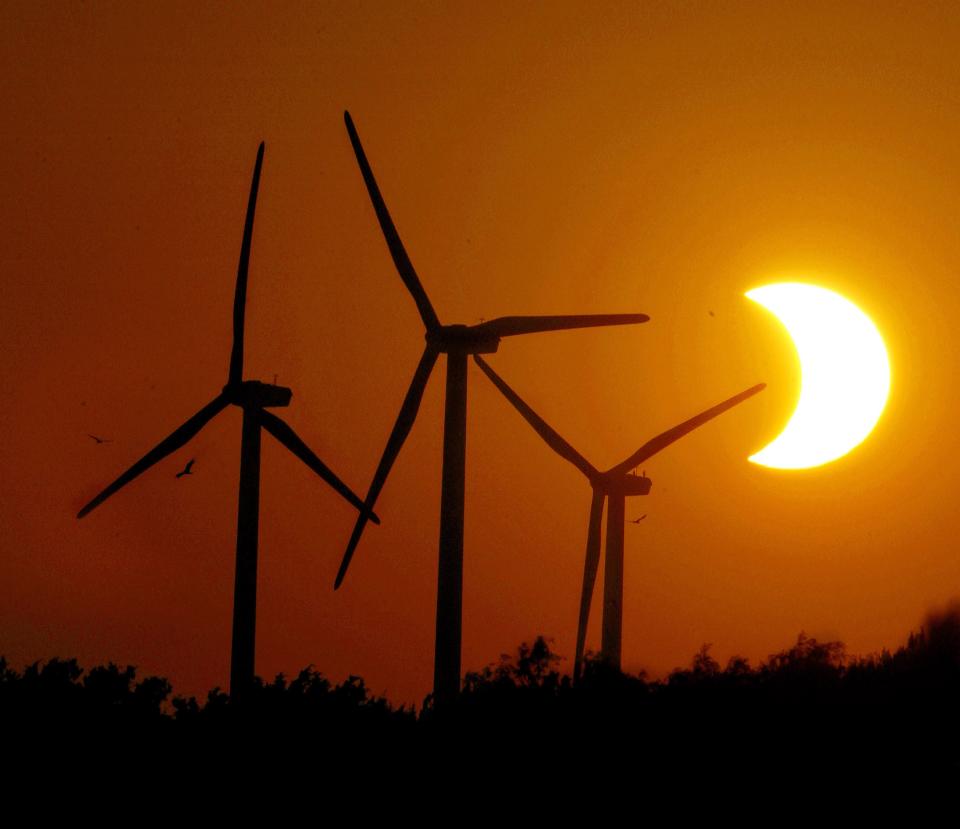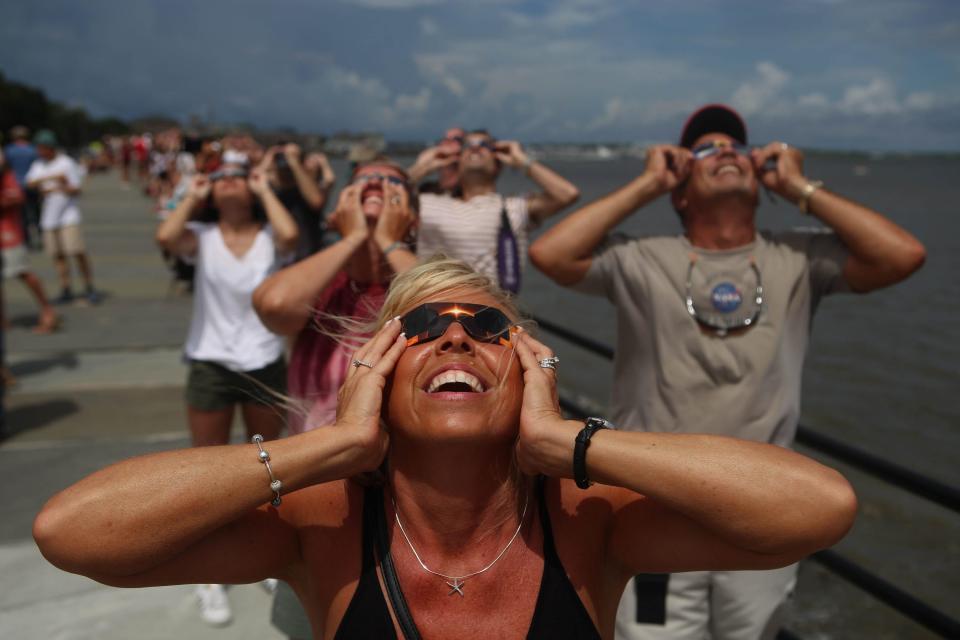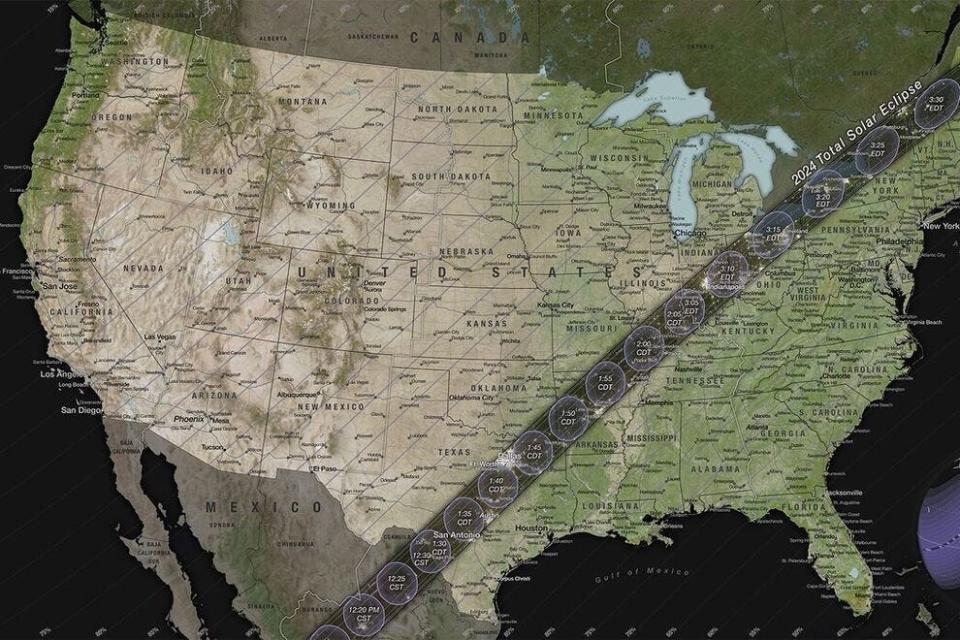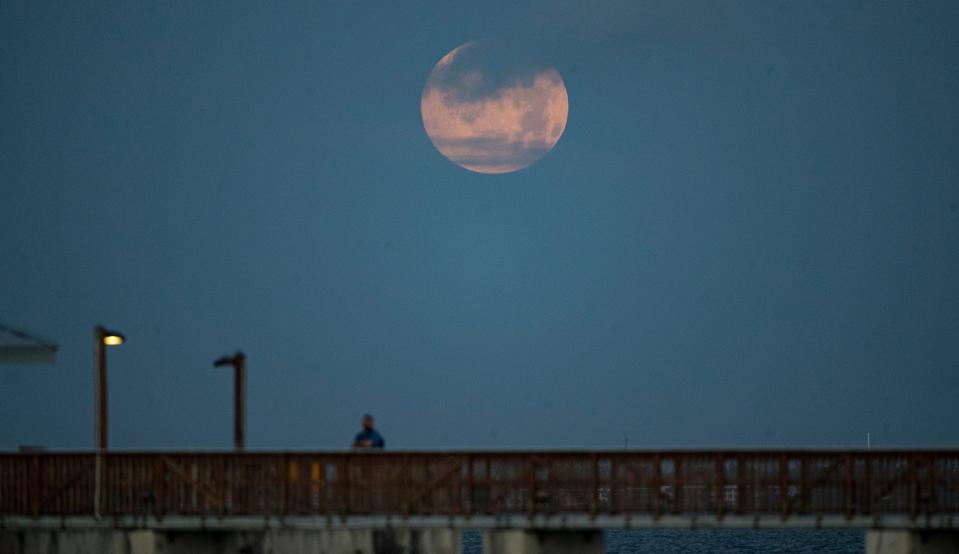The total solar eclipse is just 3 days away: Where will clouds, storms spoil the view?
We're in the home stretch now: North America's much-ballyhooed total eclipse of the sun is now just a mere three days away.
The total eclipse will pass over parts of roughly a dozen U.S. states as it moves from Texas to Maine on the afternoon of April 8. Millions of people are expected to travel to see it, which will also attract scientists from across the country to study its unique effects on the Earth and its atmosphere.
The full total solar eclipse experience will plunge people along a narrow path into darkness midday, but people outside the path of totality can still use eclipse glasses (maybe free eclipse glasses) to see the moon pass in front of the sun.
That is, if clouds don't get in the way.

Where are clear skies most likely?
Within the path of totality, the best chances for clear viewing are in "northern New England and from southern Missouri to central Indiana," the Weather Prediction Center said Friday.
The National Weather Service forecast office in Burlington, Vermont, said "sky cover is still looking mostly sunny for eclipse day on Monday." In New York State, the Albany office confirmed the good forecast: "We have good news for those wishing to view the eclipse. Very pleasant spring weather conditions arrive just in time for the start of the new work week and the day of the Great North American Solar Eclipse."
Where might clouds spoil the view?
Based on past weather patterns, the Hill Country of Texas was supposed to be the ideal location for eclipse viewing: Texas' typically sunny weather, major cities such as Austin and San Antonio that are ready for tourists, and location under the path of totality all combined to make it an easy recommendation for people willing to travel.
But those hopes appear to be dashed as of Friday.
The National Weather Service in Austin/San Antonio said that widespread clouds are likely in that part of Texas Monday afternoon, and that "for now eclipse viewability through the cloud cover is expected to be poor."
In addition to clouds, AccuWeather says that portions of Texas will have to endure stormy weather on Monday: "Showers and drenching thunderstorms can occur across east Texas and the lower Mississippi Valley on Monday and slowly move northward into southern Oklahoma later in the day and night. Some of the heavier storms can produce flooding, hail, and brief strong wind gusts."
What about around the Great Lakes?
Elsewhere, the Weather Prediction Center said that "cloud cover in the path of totality is also possible for portions of Ohio, northwest Pennsylvania, and far western New York."
The weather service in Cleveland offered a modicum of hope: "Exact details for the April 8, 2024 eclipse remain uncertain, although confidence is medium to high that the area will not experience completely opaque/overcast skies."

What time is the solar eclipse?
The eclipse will begin in Texas at 1:27 p.m. CDT and end in Maine at 3:35 p.m. EDT, but the exact time of the eclipse varies by where you are in its path. You can search by zip code to find the exact time for your location.
Monday’s solar eclipse path of totality may not be exact
A new map is projecting that the path of totality for Monday's solar eclipse may be narrower than experts previously believed. But if you're right on the edge of the path, don't go changing your plans just yet.
New amateur calculations suggest that widely-accepted path could be off by as much as just a few hundred yards. The potential shift in the eclipse's path is so miniscule, in fact, that a NASA spokesperson told the Detroit Free Press that the U.S. space agency won't be making any alterations to its own calculations.
So, even if the new calculation is more accurate, it’s unlikely to matter much for most of the millions of skygazers who hope to witness the first total solar eclipse in North America in seven years.
The new eclipse calculations come courtesy of John Irwin, a member of the team of amateur astronomers analyzing the celestial event for the Besselian Elements.
But don't fret too much: Not only is the new analysis not yet peer-reviewed, but NASA told the Free Press, part of the USA TODAY Network, that its predictions have not changed.
However, NASA spokesman Tiernan Doyle acknowledged "a tiny but real uncertainty about the size of the sun" could lead to a narrower eclipse path.

More celestial wonders on the way: 'Devil comet,' Lyrid meteor shower, pink moon also visible in April
The eclipse isn't the only sky spectacle to look forward to this month: From a "devil comet" to a stunning pink moon, a few other celestial events will give skygazers plenty of reason to look up in April once the total solar eclipse has come and gone Monday.
While the famed "devil comet" may be visible during the solar eclipse itself, astronomers say that the celestial body will be best sighted on April 21. That's the day that the comet, officially known as 12P/Pons-Brooks, will make its closest approach to the sun.
The comet earned its demonic nickname from its distinctive tail that resembles horns.

The Lyrid meteor shower will also make its annual appearance this month, with its peak on April 21-22. The Lyrids, one of the oldest-known meteor showers on record, has reliably peaked every year in late April like clockwork for thousands of years.
Finally, the full pink moon will rise in the evening sky on April 23. This month's full moon name comes from the moss pink wildflower that sprouts this time of year.

Can you drive during a solar eclipse?
It's safe to drive during an eclipse as long as you don't look up at the sky. AAA is telling drivers to be focused on the road if they are operating a car during the total solar eclipse.
The automobile insurance company is advising Americans who want to safely view the total eclipse to find a safe place to park and then wear your eclipse glasses to view the eclipse.
Authorities are also reminding people to not drive while wearing solar eclipse glasses. Eclipse glasses are designed specifically for viewing an eclipse and you would not be able to see the road adequately while wearing them.
Owls may hoot and bats may fly during the eclipse, but don't expect coyotes to howl
We human beings are giddy with excitement for the upcoming eclipse on Monday, but what about the animals? It's safe to say they don't even know it's coming. How will they react when the moon blots out the sun and it gets dark?
"It will be a complete surprise to our wildlife, but we do know from other parts of the world some will assume it's nighttime all of a sudden," said Toni Mikula, a fish and wildlife scientist with Vermont Fish & Wildlife. "Birds hurrying to go to roost. Owls starting to hoot or you might see some bats come out. Three minutes later the sun will start to rise again. Everybody will go back to normal."
Mikula doesn't expect anything overly dramatic, like coyotes beginning to howl. But she'll be monitoring reactions near her home during the eclipse.
"I'm fortunate, I have a pretty good view of the sky from my house," Mikula said. "The state is encouraging people to stay home that day. I will be outside listening to see if any owls come out to hoot."
New York inmates who claimed lockdown was religious violation will be able to see eclipse
Inmates at a New York prison who sued the state corrections department over a planned lockdown during the eclipse will be able to see the celestial event after all.
The lawsuit filed Friday in federal court in upstate New York claimed that the lockdown, which would have prevented many statewide inmates from witnessing Monday's solar eclipse, constituted a violation of religious rights.
"For many, this eclipse is a moment of monumental religious significance that cannot be overlooked or dismissed out of hand," according to the lawsuit, which listed six plaintiffs of various religious faiths.
Corrections officials agreed Thursday to permit the plaintiffs – a Baptist, a Muslim, a Seventh-Day Adventist, two practitioners of Santeria and an atheist – to view the eclipse in exchange for the lawsuit's dismissal, department spokesman Thomas Mailey told USA TODAY.
This article originally appeared on USA TODAY: Solar eclipse 2024 updates: Where will clouds, storms spoil the view?
